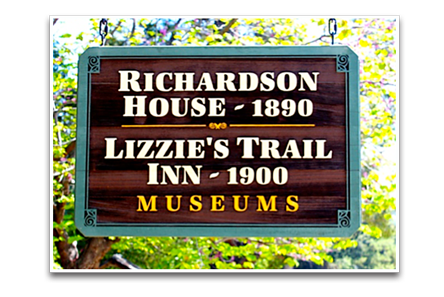Come on down
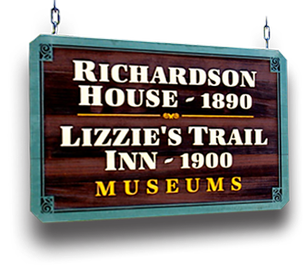
Hours:
Saturdays from 10 a.m. to noon
Address:
167 Mira Monte Avenue,
Sierra Madre (see map below)
Tours
To schedule school or special tours, please call the Museum Curator or the Education Chair
(Please click on our "Board" webpage for contact information)
Thumbnail History of the Museums
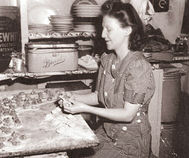 John Richardson came to this area in the early 1860s and obtained a patent to 150 acres of federal land. He developed a ranch circa 1864, and built two small dwellings, one of which has been preserved. The Richardson House and adjacent land was eventually acquired by N.C. Carter, was subsequently purchased by the Caley family, and is currently owned by the City of Sierra Madre.
John Richardson came to this area in the early 1860s and obtained a patent to 150 acres of federal land. He developed a ranch circa 1864, and built two small dwellings, one of which has been preserved. The Richardson House and adjacent land was eventually acquired by N.C. Carter, was subsequently purchased by the Caley family, and is currently owned by the City of Sierra Madre.
Elsie Orme making ravioli at Lizzie's, ca. 1940
The house has since been restored and maintained by Society volunteers and is furnished with vintage furniture and accessories. This small structure provides an intimate setting for the display of historical documents, paintings, photographs, and artifacts from Sierra Madre's early days.
Beginning about 1890, a lunch stand stood at the foot of the Mount Wilson Trail serving hikers and packers on the way up or down the popular trail. In 1913 the ever-evolving structure was moved to, or rebuilt on the east side of the trail where it continued under the management of various early day entrepreneurs. Operated by Lizzie McElwain from 1925 to 1935, "Lizzie's Trail Inn" became famous throughout the region for its unchanging menu of fried chicken and ravioli (and "distilled spirits" during prohibition).
The Lizzie's tradition was continued by Thelma and Robert Orme until the business closed in 1948. The aging structure was resorted by Society volunteers as a bicentennial project in 1976. Twenty years and four earthquakes later, Lizzie's Trail Inn was near collapse. Society volunteers are again restoring this venerable structure to insure its continued preservation and use as a museum for public enjoyment.
Detailed History of the Museums
By Chris Bachwansky
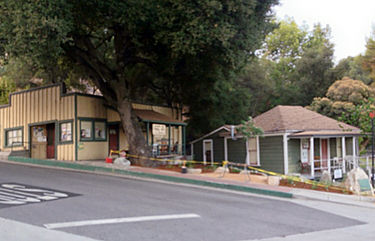
167 Mira Monte Avenue, Sierra Madre
John Richardson came to the Sierra Madre area in the early 1860s and applied for, and was granted, a patent to develop 150 acres as a ranch. By 1864 his ranch was up and running and as early Sierra Madre developed he became a fixture in the community. He built two houses. The one we know as Richardson House is believed to be the second. It was a modest two-room place with an all-purpose main room and a small bedroom. The house was built by hand, without the luxury of power tools, but John put a large porch across the front, perfect for capturing the breeze and relaxing on a summer’s evening after chores were done.
It is believed the structure was originally sited on Mountain Trail and later moved to Mira Monte Ave. At some point it was finally moved across the street to the north side of the street, where it now stands. John left the house and surrounding property to his son Levi, who sold it to N. C. Carter. Eventually the Caley family owned the house. Lizzie Stoppel lived there when she operated Lizzie’s Trail Inn. SMHPS member Maurice Orme said, ”Lizzie slept in the front bedroom, and kept her still in the living room and did most of her living up at the restaurant. “ Today you can still see the trapdoor in the floor where she hid the “hooch” in the event of a raid! Maurice, who lived in Richardson House in the late ’30s and through most of the ’40s when his family operated Lizzie’s Trail Inn, had the back bedroom as his own. It is believed to have been added to the house, along with indoor plumbing and the bathroom, sometime in the ’20s. Later, in the ’30s a utility room and storage shed were built at the back of the house, giving us the footprint we know today.
In 1890 a small lunch stand served the many hikers and packers that were drawn to the trail. Around 1913 the building was moved across the trail to where it now sits. It had many incarnations, such as a tearoom and market, before becoming “Lizzie’s Trail Inn,” owned by Elizabeth “Lizzie” Stoppel in 1924. It was a “jumping joint” by all accounts. In addition to the Richardson House, there was a near-by pack station located where Mount Wilson Park is now. Huge eucalyptus trees that were cut down in the ’40s surrounded the area.
In addition to Lizzie’s signature dinner of fried chicken and ravioli, one item not advertised on Lizzle’s menu was home brew, and it’s said that if you turned your coffee cup a certain way you’d get a little “warm up” of a special kind. The “jumping joint” also offered pinball, dancing and a one-armed bandit discreetly placed behind one of the booths near the restroom. Maurice, whose job it was to sweep up every morning says, “I got to keep all the dropped coins I found. I was the richest kid in town because I always had a little money in my pocket!” Maurice’s family operated the restaurant from 1937, when Lizzie became ill, until 1948, when food shortages made it difficult to keep the restaurant going. According to Maurice, “We could only get enough food to stay open a couple of days a week, and you can’t make a living doing that.”
After Lizzie’s closed, the properties fell into disuse and were finally acquired by the City of Sierra Madre, along with the land where the pack station had been. Through the efforts of the SMHPS, along with help and support from the entire community, our on-going preservation efforts continue to provide a doorway to Sierra Madre’s past, all made possible by generous support from our volunteers, members, and friends of the SMHPS.
Who was Lizzie?
By Jeff Lapides
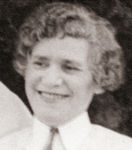 Sierra Madre knows her as Lizzie, the operator of the Trail Inn on East Mira Monte at the foot of the Mount Wilson Trail in the 1920s and ’30s. History knew her as Elizabeth Louisa Ciez Adler Weiss Stoppel McElwain. She led a colorful but all-too-short life.
Sierra Madre knows her as Lizzie, the operator of the Trail Inn on East Mira Monte at the foot of the Mount Wilson Trail in the 1920s and ’30s. History knew her as Elizabeth Louisa Ciez Adler Weiss Stoppel McElwain. She led a colorful but all-too-short life.
The roots of her family names of Ciez and Adler are unknown. Her younger son’s birth certificate lists Ciez as his mother’s maiden name. But Lizzie’s obituary in the Los Angeles Times lists her maiden name as Adler.
Lizzie was born in the Russian Empire on September 20, 1888. Her village was near Kiev in today’s Ukraine. According to her obituary in the Sierra Madre News of January 4, 1939, within months of her birth, her mother died and her father was killed. The story continued: A family with nine children took her in, and when she learned in 1906 of being adopted, the now-eighteen-year-old Elizabeth ran away to Kiev. A kind woman in the city welcomed the girl into her family. As it turned out, this woman was a sister of Elizabeth’s birth mother – her aunt!
Her new family immigrated to Cincinnati, Ohio, in 1909. Lizzie met her first husband, Louis Weiss, and they married in Cleveland. They welcomed their first child, Joseph, in Ohio and relocated to Los Angeles in 1911. In 1913, their second son, Ruben, was born.
By 1920, Lizzie was the landlady at a rooming house at 309 Temple Street in Los Angeles (currently the site of the County of Los Angeles Heating and Refrigeration Plant). According to the previously cited obituary, she was fluent in nine languages and volunteered as an interpreter at the Los Angeles County Hospital on Mission Road on the east side of the Los Angeles River. Her husband passed away the following year. It’s worth noting that Mr. Weiss was thirty-five years Lizzie’s senior.
Residing at the rooming house was Louis August Stoppel who was to become Lizzie’s second husband in 1927. In the meantime, according to Dr. William White in 1996, Mrs. Elizabeth Weiss bought the business at the Trail Inn on her birthday in 1925. By October of the following year, Louis Stoppel’s name appeared on search warrants and a disposition of a guilty plea for illegal manufacturing of alcohol at the Trail Inn and the adjacent Richardson House.
During Lizzie’s years at the Trail Inn, the establishment developed a sterling reputation for her kitchen fare, especially her fried chicken and her ravioli dinners. It also had a less savory back story of sexual trysts in the three Gill Sanss above the inn, and, of course, the moonshine. But everyone agreed that Lizzie was most congenial and had many friends.
On November 1, 1935, Lizzie’s declining health (thought to be due to breast cancer) led her to relinquish the Trail Inn. Louis Stoppel had left Lizzie sometime in the early years of the decade. But on December 16, she once again assumed the lease and the business. In 1936 Lizzie married Edward Harding “Mac” McElwain and got the support she needed.
Even though Lizzie was ill, she continued to personally pay bills and taxes through December of 1938. But the end came on January 3, 1939, at the age of fifty. Lizzie is buried in East Los Angeles at the Home of Peace Memorial Park on Whittier Boulevard.
Lizzie’s Trail Inn lives on as the SMHPS’s mountain history museum, open Saturdays between 10 a.m. and noon. The spirit of Lizzie—congeniality and friendship—continues to greet all visitors.
View Larger Map
